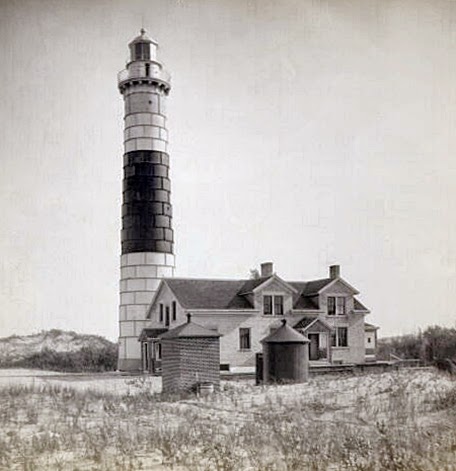Lighthouse in 1914 before lantern was painted black. Photograph courtesy Archives of Michigan
Called Grande Pointe au Sable by French explorers and traders, Big Sable Point, located roughly nine miles north of Ludington, was a prominent landmark for mariners traveling this treacherous stretch of Lake Michigan. Congress appropriated $6,000 for a lighthouse on Big Sable Point in 1856 and the Michigan Legislature ceded the necessary land the following year, but only $888 was spent before the remainder of the appropriation reverted to the treasury. Following the Civil War, the matter of a lighthouse for Big Sable was picked up again, when the Lighthouse Board noted in 1865 that the point was the most important point on the eastern shore of Lake Michigan between Pointe Betsie and Muskegon and that the “interests of commerce demand that it be suitably lighted.” Congress appropriated $35,000 for the lighthouse in July 1866 and work soon got underway at the site. A stone foundation, extending six-and-a-half feet below the ground was first prepared, and atop this a brick tower was built that tapered from a diameter of roughly nineteen feet at its base to just over thirteen feet at the lantern room. Eight circular windows provide light for the tower’s interior. The upper portion of the 112-foot tower consists of a watchroom, encircled by a gallery, and the lantern room, in which a third-order L. Sautter & Cie. Fresnel lens that produced a light with a focal plane 106 feet above water level was installed. The dwelling for the keepers was connected to the southern side of the tower by a fourteen-foot-long covered passageway. Built of Milwaukee Cream City Brick, which was also used for the tower, the one-and-a-half-story dwelling had an apartment on the ground floor for the keeper and one upstairs for the assistant keeper. Alonzo Hyde, the first head keeper, lit the tower’s lamp for the first time on November 1, 1867, sending forth a fixed white light that could be seen for up to nineteen miles. The lighthouse originally consisted of a tall conical, cream-colored tower. However, the soft-faced Milwaukee brick used in construction of the tower proved to be no match for the elements and wind-driven sand. In 1898, the brick was in bad condition. By 1899, it was apparent that measures had to be taken to preserve the deteriorating brick in the tower. A contract to address this issue was entered into on December 14, 1899, and the following year the tower was encased in eighteen metal cylinders, with different diameters, that were placed one on top of the other. The metal had a thickness of three-eighths of an inch, and the space between the cylinders and the tower was filled with concrete. When the work was completed in June 1900, the metal tower was painted white with its middle third black. In October 1916, its current daymark was established when the color of the watchroom and lantern room was changed from white to black. The modern conveniences of electricity, provided by a diesel generator, and indoor plumbing and heating were added to the station in 1949. Power lines were extended to the point in 1953. In 1968 the tradition of light-keeping begun in 1867 ended when the station was fully automated. Coast Guard personnel left the station for good in April 1971.








No comments:
Post a Comment